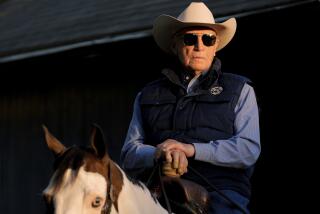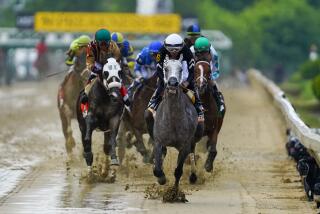Shakin’ Up the Triple Crown
- Share via
Churchill Downs and Pimlico announced last week a change in the way post positions will be determined for the Kentucky Derby and the Preakness.
In a sport that reveres tradition, the new system will be considered radical, and the tradition-bound New York Racing Assn. won’t adopt it for the Belmont Stakes. But the Triple Crown tracks might have improved their showcase product if they had considered an even more radical change.
Post positions for all thoroughbred races are determined randomly, as a numbered ball, or “pill,” is pulled from a bottle.
But at the Derby and Preakness, this blind draw now will determine only the order in which owners and trainers pick their own post positions.
In a 20-horse Derby field, the first trainer to choose might opt for Post 1; if he feared that his horse would get blocked on the rail, he might pick a spot in the middle of the pack. The next selector would have his choice of the 19 remaining numbers. Because the far outside post positions are the most disadvantageous, the final selectors would be stuck with wide posts, and the 20th to choose would almost certainly wind up with Post 20.
Three-time Derby-winning trainer Wayne Lukas remarked: “There is going to be a lot of strategy that centers around what your horse prefers. If you have a horse who’s tense or fractious in the gate, you might want him on the outside so he’s not standing in there too long. Or you might have a horse with an affinity for running on the outside.”
Lukas said the last post he would pick at Churchill Downs would be Post 1. Considering that the inside post has produced more Derby winners than any other, Lukas might be widely second-guessed.
And that is the very point of this change: to inject some interest in the humdrum post-position draw and ESPN’s hour telecast of it.
Churchill Downs President Tom Meeker said, “We have an obligation to do what we can to promote our sport, and through our connection with ESPN, we have a way of creating some additional interest.”
By involving the trainers and owners with horses in the race, the new post-position draw would put them before a national television audience and generate more interest in the upcoming race.
Lenny Hale, Pimlico’s vice president for racing, echoed this sentiment.
“People ask why we’re messing with tradition,” Hale said, “but we’re making this change because it’s a change for the better--one which will give us more media exposure.”
Unfortunately, the change announced last week does nothing to address a major problem with America’s most famous race.
Because the Derby often has oversized fields, its outcome is frequently affected by post positions and racing luck. Speed horses who start on the far outside are generally compromised because they must make a frantic run to the first turn or else get hung up wide on the turn. Unbridled’s Song, the best horse in the 1996 Derby field, was doomed after he drew Post 19.
I used to think that the wide-open nature of the Derby, and the presence of so many horses who didn’t belong, was part of its democratic appeal.
But in recent years, the Derby too often has produced fluky results and unmemorable winners. As a result, the whole Triple Crown series often falls flat-an unfortunate development when these are the only races that attract widespread interest from the public and the media.
This year, by contrast, the Derby had an unusually small field and was little affected by racing luck. The best horse, Silver Charm, won it, setting the stage for a Triple Crown battle that galvanized public attention.
If Churchill Downs won’t reduce the maximum size of the Derby field--which it doesn’t want to do--it could use the post-position draw to keep the legitimate contenders from being compromised.
Let the trainers of the best horses pick their posts first.
The system could work something like this: A random draw would be held to determine the order of post-position selection for every entrant who had won a graded stakes as a 3-year-old. Those horses would get the prime posts. Then a second draw would involve the horses who didn’t meet the qualifying standard; the lesser contenders would get the unfavorable posts.
The tracks’ ultimate goal should be to make the Derby and Preakness better races, not just to make a better show for ESPN.
If this year’s 2-year-old standout Favorite Trick stays undefeated, goes to Churchill Downs as a much-acclaimed favorite and then winds up in Post 20, the new system won’t have accomplished much.
More to Read
Go beyond the scoreboard
Get the latest on L.A.'s teams in the daily Sports Report newsletter.
You may occasionally receive promotional content from the Los Angeles Times.










